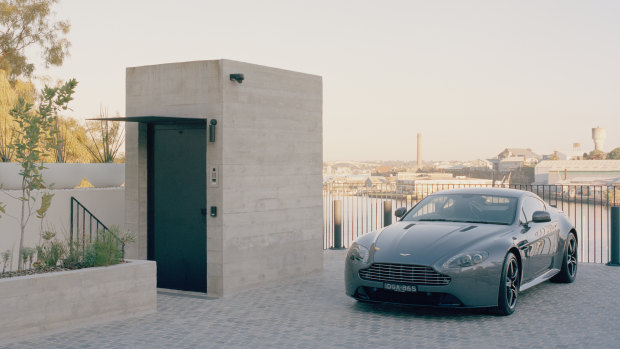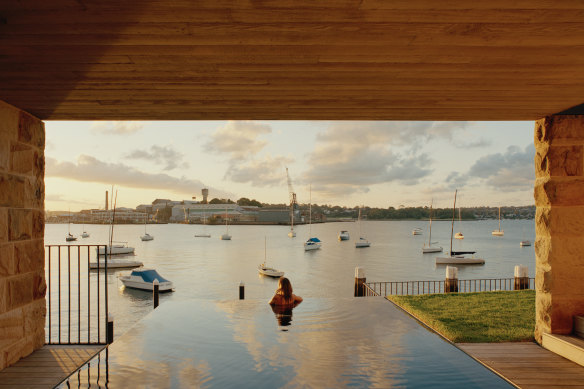- Business
- Consumer affairs
- Architecture
This was published 7 months ago
Enter this spectacular home via the stand-alone lift shaft on the street, please!
Visitors to the once-dilapidated fisherman’s cottage in Birchgrove, with spectacular Parramatta River views, enter via a stand-alone lift shaft on the street.
In Sydney’s pricey suburbs, large houses on relatively small sites are the norm as owners maximise views, often at the expense of neighbours. Constructing monumental houses that equate size with potential resale is de rigueur.

The stand-alone lift shaft on the street.Credit: Gavin Green
“The market generally suggests maximising a site and capitalising on views – but that certainly didn’t drive this project,” says architect Eva-Marie Prineas, director of Studio Prineas.
Prineas Studio was given a spectacular site to work with in Birchgrove, including a nine-metre drop to the water’s edge as well as the dilapidated fisherman’s cottage.
Unlike most top-end homes on Sydney’s harbour, there’s no basement carparking for half a dozen cars in the cottage that dates back to the late 19th century and the neighbour’s views over Parramatta River and Cockatoo Island have been maintained.
While many would have simply bowled over the 60-square-metre cottage and built the ‘home of their dreams’, both the architect and the client, a couple with two small children, decided to build on the past and allow the streetscape, including the views of the river, to be enjoyed by the locals.

There’s a modest-size pool, complete with a sauna and a bathroom – with the veranda above creating protection from the more inclement weather.Credit: Gavin Green
The only sign of a building at street level is a concrete lift shaft, with adjacent parking on the open terrace for a couple of cars. “We didn’t see the point of designing a five-level home (with two storeys at street level) just because we could have. Nor were we persuaded to demolish the cottage even though most of these along the shoreline have long gone,” says Prineas, who even went against the advice of a heritage architect who saw the humble cottage as having little heritage value.
Fortunately, both client and architect shared similar values, not only wanting to retain the past, but also mindful of the layers of history. “There’s the rock face to start with that goes back thousands of years – so we wanted to also reinstate the indigenous landscape,” says Prineas, who worked closely with Bushy Landscapes.
The cottage on the lowest level was also given the same respect, with the exterior corrugated walls removed to reveal the original timber boards. It needed a major overhaul, so the non-load bearing dividing boards were removed and new steel beams inserted. Together with the new Japanese-stained timber insets into the original Kauri floor, one can still ‘read’ how the original cottage would have been carved up.
What was an outhouse is now a veranda and the cottage is an open-plan kitchen, dining and living area. Simple smoked oak veneer joinery lines the kitchen, with one cupboard dedicated to appliances. Rather than revealing a blank wall, there’s the cottage’s original timber-framed multi-paned window, offering additional light when left open. “It’s about memory as much as about creating contemporary spaces for a family,” says Prineas, who treated the acrylic carbon-like island bench like a piece of furniture, ‘floating’ above the original floors.
However, mindful of the future as much as the past, Prineas Studio added to the cottage, with a guest bedroom, a study, a bathroom, a laundry, and a cellar also found at this level. Above are the two children’s bedrooms, a shared bathroom and a study nook, orientated to a sandstone rock face buried deep into the site. The new rooms feature concrete walls and concrete ceilings.
And on the top level, is the main bedroom and ensuite, treated like a sumptuous hotel suite. Featuring a marble-lined bathtub behind the bed, the owners can still enjoy the views of the water through the mirrored wardrobes.
“They can also have similar water views when they’re brushing their teeth,” says Prineas, pointing out the dual basins. Her team also thought about the smaller details of staying in a luxe hotel and included a kitchenette/bar behind one of the cupboards so they didn’t need to take the stairs or the lift to the kitchen.
While neighbouring houses might have the ubiquitous swimming pool at the end of the garden, accessed from a manicured lawn, there wasn’t the room or desire to replicate these features on this property. Instead, there’s a modest-size pool, complete with a sauna and a bathroom – with the veranda above creating protection from the more inclement weather.
From the street, the now 250-square-metre house is expressed as a simple concrete lift shaft – no more. The water views that can be enjoyed by those strolling past or neighbours directly opposite. One can only imagine their joy at seeing this simple addition rise in the street – a first in many of Sydney’s prized waterfront locations.
The Market Recap newsletter is a wrap of the day’s trading. Get it each weekday afternoon.